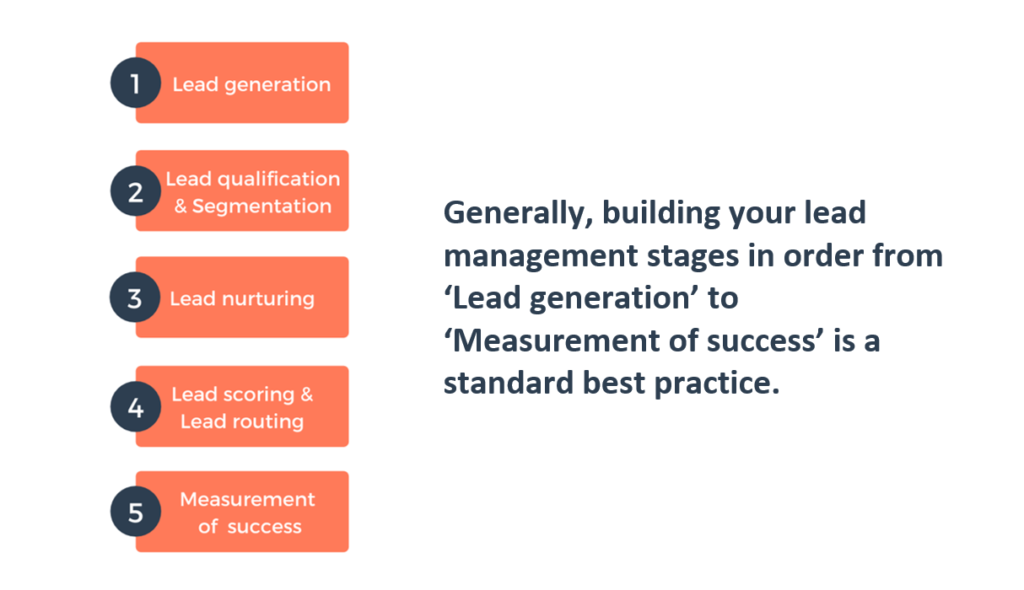Are you frustrated by the constant struggle to handle leads effectively?
For many marketers and business owners, the process of lead management can feel like an endless maze.
It’s not just about capturing leads; it’s about losing valuable opportunities due to disorganized lead handling. The chaos can result in missed sales, wasted resources, and a sinking bottom line.
Isn’t it time for a change?
The answer lies in effective lead management. By implementing a robust lead management system, you can finally take control of your leads, nurture them strategically, and watch your conversion rates skyrocket.
So, don’t let your leads slip through the cracks any longer.
Take action today and transform your business with a streamlined lead management approach that delivers real results.
What is lead management?
Lead management is the systematic process of capturing, organising, nurturing, and ultimately converting potential customers or “leads” into paying customers. It involves the strategic handling of inquiries, interactions, and data related to individuals or businesses that have shown an interest in your products or services. Lead management aims to ensure that no potential sales opportunity is lost, and it includes activities such as lead generation, lead scoring, lead tracking, and lead nurturing to guide leads through the sales funnel, ultimately resulting in increased revenue and business growth.
Why is lead management important to sales & marketing?
Lead management is of paramount importance to both sales and marketing because of the following reasons:
Efficient resource allocation
Effective lead management ensures that sales and marketing resources are allocated to leads with the highest potential for conversion. This optimization prevents wastage of time and effort on leads that are unlikely to convert, thus increasing overall productivity.
Enhanced customer understanding
Lead management allows businesses to collect and analyze data about their leads, helping them gain insights into customer preferences, pain points, and behaviors. This information can be used to tailor marketing strategies and sales pitches, making them more compelling and relevant.
Shorter sales cycles
Through lead nurturing, leads are guided through the sales funnel more efficiently. This shortens the sales cycle, as nurtured leads are more likely to make purchasing decisions sooner, reducing the time and resources required to close deals.
Improved lead quality
Lead management involves lead scoring and qualification, ensuring that only high-quality leads are passed on to the sales team. This minimizes the chances of sales teams pursuing unqualified leads and focuses their efforts on those with genuine interest.
Increased revenue
By optimizing lead management, businesses can experience higher conversion rates, leading to increased sales and revenue. Effective lead nurturing can also foster long-term customer relationships, resulting in repeat business and referrals.
Alignment between sales and marketing
Lead management encourages collaboration between sales and marketing teams. Clear communication and shared goals lead to a more cohesive approach to customer acquisition, resulting in a more effective sales and marketing strategy.
Customer retention
Lead management doesn’t end with the sale; it extends into post-purchase nurturing and engagement. This approach ensures that customers are satisfied, more likely to become repeat buyers, and advocates for your brand.
In essence, lead management is the linchpin that connects sales and marketing efforts, ensuring that leads are efficiently and effectively guided from initial interest to conversion, ultimately driving business growth and success.
Developing a Lead Management Strategy
In the ever-evolving landscape of business, the ability to develop a robust lead management strategy is nothing short of indispensable. This skill is crucial because it empowers you to harness the full potential of your customer base, optimize your marketing efforts, and drive higher conversions.
Without a well-defined lead management strategy, you risk wasting resources, missing out on valuable sales opportunities, and struggling to maintain a competitive edge in your industry.
Now, I offer you an ideal solution: a comprehensive guide that will walk you through the steps of creating a highly effective lead management strategy tailored to your business. This method will equip you with the knowledge and tools needed to maximize your leads’ potential and ultimately boost your bottom line.

Source: Hubspot
Step 1- Audit your lead management process
Before you can enhance your lead management strategy, it’s essential to assess your current processes to identify strengths and weaknesses. Here’s how to execute this critical step:
- Gather Your Team
- Document Your Current Process
- Identify Key Metrics
- Analyze Data and Feedback
- Compare Against Best Practices
- Assess Technology and Tools
- Identify Pain Points
- Set Goals and Objectives
- Create an Audit Report
- Prioritize Improvements
By completing this audit, you’ll have a comprehensive understanding of your existing lead management process and a solid foundation upon which to build an improved strategy in the subsequent steps. The insights gained from this evaluation will be invaluable as you work to streamline your lead management and drive better results for your business.
Step 2- Define your lead lifecycle stages
Defining clear lead lifecycle stages is a critical component of effective lead management. These stages represent the various phases a lead goes through from initial contact to becoming a customer. Here are the stages along with examples:
Stage 1: Subscribers
Subscribers are individuals who have shown interest in your content, typically by signing up for newsletters or updates. For example, a website visitor subscribes to your weekly email newsletter to receive industry insights.
Stage 2: Lead
Leads are prospects who have taken a specific action, such as filling out a contact form, downloading an eBook, or attending a webinar. For example, a lead provides their contact information in exchange for access to a comprehensive industry report.
Stage 3: Marketing Qualified Lead (MQL)
MQLs have demonstrated a higher level of engagement with your brand or product and are more likely to respond positively to marketing efforts. For example, a lead regularly engages with your blog content, attends webinars, and follows your social media updates.
Stage 5: Sales Qualified Lead (SQL)
SQLs are leads who have indicated a clear interest in purchasing your product or service and are considered ready for direct sales engagement. For example, a lead requests a personalized product demonstration or initiates a live chat with your sales team to discuss pricing options.
Stage 6: Opportunity
Opportunities are leads or prospects actively being pursued by the sales team, often after expressing strong purchase intent. For example, a lead has requested a formal proposal and is in negotiations with your sales representatives.
Stage 7: Customer
Customers are individuals or businesses who have made a purchase and are now officially clients or customers of your business. For example, a lead signs a contract or makes an online purchase, completing the transition into a paying customer.
Stage 8: Advocate
Advocates are highly satisfied customers who not only make repeat purchases but also actively promote your brand, provide referrals, and engage positively with your content. For example, a customer not only buys from you regularly but also refers others to your business and leaves positive reviews on social media.
Custom Stages
Depending on your specific business needs, you can create custom lead stages to align with your unique sales processes and customer journey. For example, a software company might introduce a “Product Trial” stage for leads currently testing their software before making a purchase decision.
By defining these lead lifecycle stages, you provide a structured framework for understanding where each lead stands in their journey and what actions are appropriate at each stage. This clarity is essential for tailoring your marketing and sales efforts to guide leads smoothly through the conversion funnel.
Step 3- Setting Goals with a Service Level Agreement
Establishing clear goals and expectations between your marketing and sales teams through a Service Level Agreement (SLA) is essential for efficient lead management. This step ensures that both teams are aligned and working towards common objectives.
Here’s how to execute it:
- Assemble Key Stakeholders
- Define Lead Handoff Criteria
- Establish Response Time Targets
- Set Lead Acceptance Criteria
- Define Lead Follow-up Procedures
- Establish Reporting and Feedback Mechanisms
- Determine Escalation Procedures
- Monitor and Adjust
- Document the SLA
- Training and Onboarding
- Implement Tools and Technology
By implementing a well-defined SLA, you establish clear expectations, improve communication, and create a seamless handoff process between marketing and sales. This alignment ensures that leads are managed efficiently and increases the likelihood of successful conversions, ultimately driving revenue growth for your business.
Step 4- Mapping out your Lead Management Process
To create your lead management map, begin by using a matrix-style diagram that includes both the stages of the buyer’s journey and the corresponding marketing or sales activities. Afterward, identify all your lead management activities and place them in their respective sections within the matrix. Organize these activities to align with a lead’s progression through their buyer’s journey, moving from left to right.
Once you’ve established this framework, draw arrows to indicate the potential transitions between activities for each lead. Lastly, include lifecycle stages at each transition point on your map. To simplify this process, you can access our lead management map template in the resources section below.
Whether your map appears relatively empty or is filled to capacity, it’s important to note that this map will continuously evolve over time. However, to maintain an effective and streamlined strategy, it’s crucial to map out your process comprehensively. Doing so ensures that all activities are accounted for and provides clarity for your team members regarding their respective responsibilities. By crafting a well-defined lead management process, you’ll be able to streamline and simplify your approach, fostering confidence among your team members.
Step 5- Optimise your Lead Management Strategy with Marketing meetings
Now that you’ve defined your lead lifecycle stages, set goals, and mapped out your lead management process, it’s time to put your strategy into action and establish systems to keep your teams aligned. Here’s why this matters:
Avoiding Drift
As your marketing and sales teams get to work, it’s common for them to gradually move away from the original strategy. Even with goals and an SLA in place, maintaining alignment can be challenging without proper systems.
Adapting to Change
Over time, your company may grow and evolve. What works for your lead management today may not work in the future. To ensure your strategy remains effective, you need a recurring system to identify areas for improvement.
One crucial system is regular “smarketing” meetings, where your sales and marketing teams collaborate to address challenges and find solutions. Here’s how to run effective smarketing meetings:
Three Key Elements for Effective Marketing Meetings
- Focus on Problem-Solving
- Choose the Right Cadence
- Be Selective with Attendees
By adhering to these best practices, you can ensure that your marketing meetings are productive and contribute to the ongoing optimization of your lead management strategy. As your company grows and evolves, remember that your lead management strategy may require frequent adjustments.
Rather than aiming for perfection, focus on developing a strategy and continuously refining it over time. This way, your team will always have a guiding light as your lead management strategy adapts to changing circumstances.
Segmenting & Qualifying your Leads
Effective lead segmentation and qualification are vital skills in lead management. These skills enable businesses to categorize and prioritize leads based on their characteristics and behaviors, ensuring that resources are directed toward the most promising prospects.
How can marketing organize & segment their leads?
Your marketing team plays a crucial role in lead management, responsible for generating new leads and delivering qualified ones to the sales team. However, not all leads are immediately ready to make a purchase.
In fact, Gleanster Research suggests that 50% of leads may be qualified but not yet ready to buy.
This is where segmentation becomes invaluable.
Segmentation involves dividing your leads into sub-groups, or segments, based on shared characteristics. Sending generic emails to your entire database is a common marketing mistake. Instead, segmentation allows you to organize your leads based on their goals, needs, and where they are in their buyer’s journey. This enables you to send the most relevant and helpful content to each segment, a critical component of effective lead nurturing campaigns.
Lead nurturing, a pivotal stage in lead management, involves delivering the right content to the right individuals at the right time. By segmenting your contacts based on their characteristics, you enhance the effectiveness of your email marketing efforts and drive better results.
When it comes to segmentation, one of the most important types of segments for lead management is lifecycle segments. These segments categorize your contacts based on where they are in their buyer’s journey within your organization. For example, HubSpot offers default lifecycle stages, including Subscriber, Lead, Marketing qualified lead, Sales qualified lead, Opportunity, Customer, Evangelist, and Other.
Lifecycle segments allow you to tailor your communications to specific groups. For example, you can send software update announcements to your customer segment, excluding those who won’t benefit from it.
As your company generates more leads, your segmentation strategy should evolve to accommodate various criteria such as buyer personas, product interests, and unengaged or unsubscribed leads.
How can sales qualify their leads?
Now, we delve into the crucial question of determining which leads should be handed over to the sales team. The collaboration between marketing and sales in managing leads can sometimes blur the lines of responsibility.
To navigate this, it’s essential to integrate lead qualification into your lead management process.
Lead qualification entails identifying leads that are primed to enter the sales process. In the typical path to purchase, most leads entering your database require further nurturing before they’re ready to make a purchase. This underscores the importance of segmentation to provide relevant lead nurturing campaigns. Yet, some leads might be ripe for sales outreach, making lead qualification vital for discovering new sales opportunities.
To execute lead qualification effectively, two primary steps are essential. First, you need to define what constitutes a qualified lead for your specific company. This involves creating an ideal customer profile, which outlines the basic attributes required for someone to be considered a good fit for your offer. For instance, if you run a pet daycare company in San Diego, your ideal customer profile may include criteria like residing in San Diego, owning a pet, having a certain income level, and up-to-date pet vaccinations. This binary approach simplifies the qualification process.
Once you’ve established the ideal customer profile, the next question to answer is, “What actions indicate that someone is sales-ready?” These actions could involve repeated visits to your services page, downloading a comparison guide, or booking a facility tour, for example. These actions don’t guarantee a purchase, but they signify a likelihood of interest.
To successfully qualify leads, automation plays a pivotal role. Instead of manually checking if a lead meets the qualification criteria, HubSpot can be used to create Lists or Saved views.
How to automate & scale your leads?
Automating and scaling your leads in your Customer Relationship Management (CRM) system is essential for efficiently managing a large number of leads while ensuring that no potential opportunities are missed. Here are steps to help you automate and scale your leads effectively in your CRM:
- Choose the Right CRM System
- Lead Capture Automation
- Chatbots
- Lead Segmentation
- Lead Scoring
- Automated Email Marketing
- Lead Assignment Rules
- Follow-Up Automation
- Integration with Marketing Tools
- Lead Tracking and Analytics
- Lead Data Enrichment
- Automated Reporting
- CRM Training
- Continuous Optimization
- Scale Responsibly
By following these steps and leveraging the automation capabilities of your CRM system, you can effectively manage, nurture, and scale your leads while maintaining a high level of efficiency and effectiveness in your lead management process.
Lead Nurturing
If you’re like most businesses, increasing lead conversion is a top priority. While there are various strategies for email marketing and sales outreach, not all of them effectively engage leads and drive conversions. This is where lead nurturing comes into play.
‘Lead nurturing’ is a crucial step in the lead management process. It involves building relationships with prospects with the ultimate goal of winning their business when they’re ready. Lead nurturing primarily focuses on engaging and nurturing leads in your database who are not yet prepared to make a purchase.
The benefits of lead nurturing are significant.
Companies that excel at lead nurturing generate 50% more sales-ready leads at a 33% lower cost.
To launch a successful lead nurturing campaign, you need five fundamental elements:
Buyer Personas: Create semi-fictional representations of your ideal customers based on data and insights. These personas guide content and messaging customization.
Content: Develop strategic content that addresses leads at different stages of the buyer’s journey: awareness, consideration, and decision stages.
Emails: Use emails as the primary communication channel to educate and nurture leads. Personalization and relevance are key.
Segmentation: Divide your leads into sub-groups based on shared characteristics, such as buyer personas or buyer’s journey stage. Segmentation ensures tailored content delivery.
Automation: Implement automation through workflow tools to enroll leads based on criteria, send relevant emails, schedule delivery times, and remove leads when they meet campaign goals.
By combining these elements, you can create lead nurturing campaigns that effectively engage leads and increase the likelihood of converting them into satisfied customers.
How to create a lead nurturing campaign?
Lead nurturing involves the strategic process of delivering the right content, at the right time, to the right people throughout their buyer’s journey. HubSpot serves as an excellent example to facilitate this process. There are five essential steps to create an effective lead nurturing campaign using HubSpot:
Develop a Strategy
Start by setting a SMART goal (Specific, Measurable, Attainable, Relevant, Timely) for your campaign. Identify a buyer persona to target, which is a semi-fictional representation of your ideal customer based on data and insights. Map out this persona’s buyer’s journey, considering the awareness, consideration, and decision stages.
Create Relevant Content
Develop content tailored to each stage of the buyer’s journey. For the awareness stage, offer resources like eBooks, guides, or how-to videos. In the consideration stage, provide comparison guides or case studies. For the decision stage, offer free trials, demos, consultations, or coupons. Host these resources on your website, using tools like HubSpot’s File Manager and landing page builder.
Craft Engaging Emails
Build a series of emails that promote the content for each stage of the buyer’s journey. Space out email sends to give leads time to absorb the content. Write concise and compelling subject lines, incorporate visuals, personalize content, and include clear calls-to-action.
Segment Your Audience
Utilize segmentation to divide your contacts into sub-groups based on shared characteristics such as buyer personas or where they are in their buyer’s journey. HubSpot allows you to create tailored emails for each segment, ensuring relevance.
Automate with Workflows
Create a lead nurturing workflow in HubSpot to automate the entire process. Define a workflow goal (e.g., form submission), set enrollment triggers (e.g., downloading a specific guide), add delays between emails, and include the emails you’ve crafted. Test your workflow and make adjustments as needed. Consider mapping out your workflow on paper before building it.
Additionally, consider creating a campaign within HubSpot to centralize all campaign assets and facilitate collaboration among team members. HubSpot offers comprehensive metrics for tracking the success of your campaign, allowing you to measure, iterate, and optimize based on real-time insights.
Remember that while technology plays a vital role, personalization and providing valuable experiences to your leads are key to successful lead nurturing campaigns. By following these steps, you can effectively engage leads and guide them toward becoming happy customers.
Lead Scoring & Lead Routing
Sales professionals have a thrilling opportunity to transform potential leads into satisfied new customers. This makes it crucial to pinpoint the leads that exhibit the most interest in your offerings. One valuable strategy to achieve this is through lead scoring.
Lead scoring is a component of the fourth stage within the lead management process. It entails assigning a numerical value to leads to determine their priority for outreach. This systematic approach liberates your sales teams from the tedium of manually evaluating leads, allowing them to concentrate on sealing new deals.
To grasp lead scoring better, think of it as akin to the personalized content recommendations you find on platforms like Netflix. In the same vein, sales teams can effectively identify the most promising leads using a lead scoring algorithm.
The right time to introduce lead scoring into your operations is when your business regularly encounters incoming leads and opportunities. This approach is particularly beneficial if your sales team often grapples with unqualified leads or if they are short on manpower to engage with all incoming leads.
How to manage sales qualified leads with lead routing?
Sales representatives shoulder multiple responsibilities when it comes to lead management. Ensuring they have the necessary tools and support to effectively convert leads into customers is paramount.
One crucial tool in achieving this is lead routing.
Lead routing involves the automated allocation of leads to members of a sales team and plays a pivotal role in the fourth stage of lead management. It collaborates with lead scoring to ensure that Marketing and Sales work together to direct the right leads to the appropriate sales representatives.
To grasp the concept, imagine lead routing as akin to the baggage handling systems in airports. Travelers check in their luggage at the airport, trusting that it will reach the correct airplane in a timely manner. Similarly, lead routing ensures that the right leads reach the right sales representatives promptly.
But why opt for lead routing when you can manually inform sales reps about new leads?
Manual notifications are susceptible to human error. Lead routing, on the other hand, automates this process, leaving no room for leads to be overlooked. This is particularly beneficial for businesses with dedicated sales representatives for specific regions or criteria. For example, if certain sales reps exclusively handle leads from Colombia, you can automate the process of directing leads from that location to the appropriate sales rep. This enhances accuracy and speed, reducing the follow-up time for sales reps and increasing the likelihood of generating new opportunities.
Optimizing your lead routing process involves adhering to best practices:
- Ensure rapid and consistent follow-up with new leads, as research indicates that faster responses significantly improve conversion rates.
- Regularly clean your lead database by updating missing data, rectifying errors, and eliminating duplicates.
- Review the activity history of leads before reaching out to personalize interactions and identify existing interactions within your organization.
- Use a CRM platform, like HubSpot’s, to centralize lead information and streamline lead hand-offs, providing a single source of truth for your teams.
Establishing effective lead scoring and lead routing systems is just the beginning of efficient lead management. HubSpot’s deals pipeline tool can further assist in this regard. By combining lead scoring and lead routing, you empower your sales team to confidently nurture relationships with new prospects, ensuring a seamless lead transition between Marketing and Sales.
Measuring your Lead Management Success
Picture this scenario: You’ve dedicated considerable time and effort to launch new lead management initiatives for your business.
Then, your boss inquires, “How’s the progress with the lead management initiative?”
Suddenly, you find yourself pondering various aspects: your team’s accomplishments, ongoing activities, and areas for improvement. You genuinely want to provide your boss with a candid and comprehensive update, but you’re uncertain about the best approach.
If this situation resonates with you, you’re certainly not alone.
Initiating new lead management activities requires meticulous planning, trial runs, and process refinements.
Consequently, it becomes vital to furnish a detailed report on the performance of these efforts. This is why assessing the success of your endeavors constitutes an integral component of your lead management process.
Evaluating your achievements marks the fifth stage of lead management, encompassing the scrutiny of activity performance and the dissemination of these results. While it may be the concluding stage, it should by no means be the last priority on your list.
Consistently monitoring your outcomes as you develop your lead management activities is crucial. Doing so enables you to highlight the return on investment (ROI) effectively.
How to identify your lead management success metrics?
Picture this: You’ve invested significant time in launching new lead management initiatives for your business. Then, your boss asks, “How’s the progress with the lead management initiative?” You want to provide a thorough report but aren’t sure how.
This situation is common when introducing lead management activities. Measuring success is crucial, and it’s the fifth stage in lead management. It involves assessing activity performance and sharing the results.
Companies that improve their measurement and ROI capabilities tend to outgrow competitors and become more effective in marketing. Thus, measuring your efforts is essential.
To effectively measure your lead management initiatives, start by identifying your success metrics. These metrics vary based on your strategy, goals, and processes. You must determine what success means for your company.
Begin by reviewing your lead management strategy, goals, and objectives. This helps identify Key Performance Indicators (KPIs), which are crucial metrics for tracking progress. Consider questions like, “What do we plan to achieve with lead management?” and “Do we have specific targets?”
You can also analyze each stage of lead management separately. There are five stages: lead generation, segmentation and lead qualification, lead nurturing, lead scoring and lead routing, and measurement of success. Analyzing metrics for each stage provides insights into performance.
For lead generation, track metrics like visitor-to-lead conversion rate, click-through rate (CTR), and cost-per-lead (CPL). These metrics gauge how effectively you’re generating new leads.
In segmentation and lead qualification, monitor email open rates, click-through rates, segmented list growth, and segmented list engagement. These metrics assess your ability to categorize contacts and engage them effectively.
Lead nurturing focuses on educating leads through their buyer’s journey. Evaluate email open rates, click-through rates, lifecycle stage conversion rates, and content conversion rates to measure success.
Lastly, lead scoring and lead routing aim to identify and route sales-qualified leads. Track metrics like MQL-to-SQL conversion, time to conversion, and gather sales feedback.
While various data can be tracked, it’s essential to focus on a few key metrics to avoid analysis overload.
Identifying your success metrics helps align your team’s goals. So, when someone asks about your lead management progress, you can impress them by highlighting the most critical metrics.
How to report lead management results?
Lead management is a team effort involving multiple members, so it’s vital to keep everyone informed of your progress through regular reporting. This ensures alignment and effective planning.
Here are six key steps for efficient and effective lead management reporting:
1. Assign Responsibility: Determine who is responsible for reporting, considering roles in marketing and sales activities.
2. Reporting Cadence: Decide on the reporting frequency, such as weekly, monthly, or yearly reports, based on your goals and capacity.
3. Choose Reporting Tools: Utilize a reliable reporting tool, like HubSpot’s CRM, to centralize data and streamline reporting.
4. Centralize Data Sharing: Share metrics through a centralized platform, reducing reliance on shared documents.
5. Add Context: Provide context to reports with titles, descriptions, metrics, date ranges, and comparisons to previous reports.
6. Share Reports: Distribute reports to relevant team members on a regular basis, ensuring alignment and informing key leaders quarterly or yearly.
Additional Tips:
– Include key takeaways in your reports to emphasize important metrics.
– Create actionable insights from your data to drive improvements.
– Regularly measure your lead management success to identify areas for enhancement and focus on key goals.
By following these steps and tips, your team can optimize lead management reporting, gain valuable insights, and enhance the lead management process effectively.
Conclusion
In my personal experience, I’ve come to understand the critical role that effective lead management plays in the success of any business. It’s not just a process; it’s a strategic approach that involves the entire team, from marketing to sales.
Through this Lead Management Guide, I’ve learned that success in lead management is not about one-time actions but an ongoing commitment to nurturing, scoring, and routing leads efficiently.
The guide has highlighted the importance of measuring and reporting on lead management efforts. This step is often underestimated but is essential for tracking progress, making data-driven decisions, and ensuring alignment among team members. Clear communication of results, supported by contextual insights and actionable recommendations, empowers teams to continuously improve their lead management strategies.
Moreover, the guide emphasizes the significance of choosing the right tools and technology to streamline lead management processes. I’ve seen firsthand how a centralized platform, like HubSpot’s CRM, can simplify data access and reporting, allowing for more effective collaboration between marketing and sales teams.
In conclusion, successful lead management is not a one-size-fits-all approach. It’s a dynamic and evolving process that requires dedication, analysis, and adaptation. By following the steps outlined in this guide and incorporating the extra tips, businesses can unlock the potential of their leads, drive growth, and ultimately build stronger relationships with their customers. Lead management isn’t just a guide; it’s a journey towards business success.





